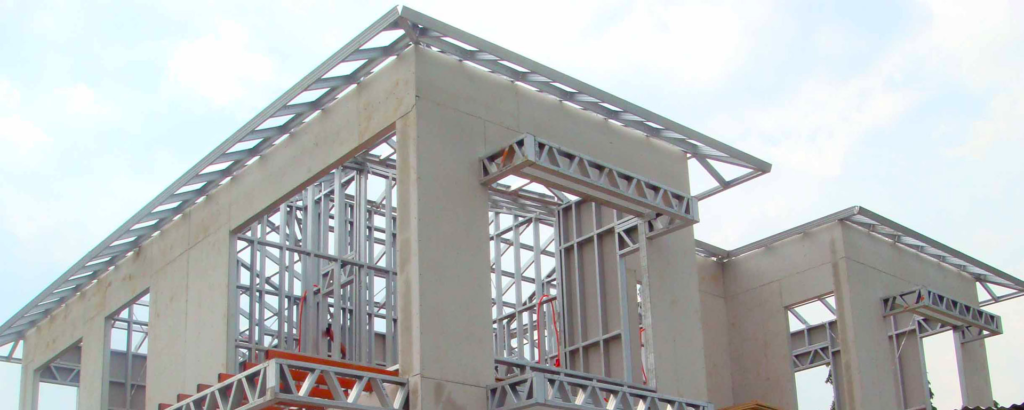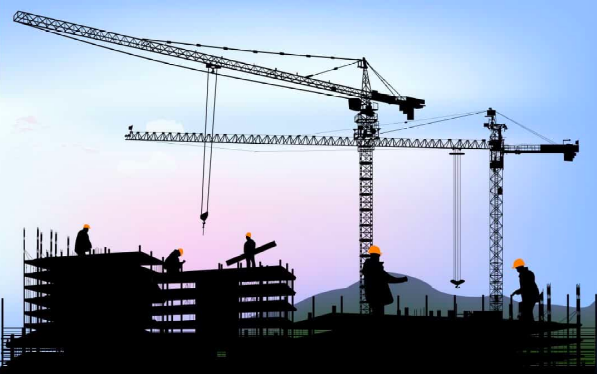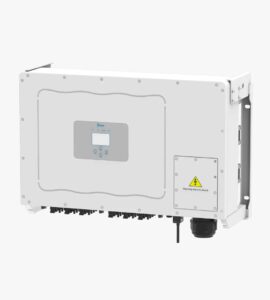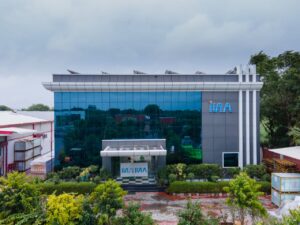Technological innovations are redefining the building and construction industry, too as it is witnessing a rapid and tremendous changes over the last many years. The changes are a result of the latest technologies the industry is adopting successfully and snubbing the conventional methods gradually.
Building and construction industry plays a pivotal role in building superior and elegant brick and mortar structures. The rapid industrial growth has seen the rise in demand for the fast execution of construction projects and rising pressure from clients/buyers for timely delivery has become a prime concern for developers. Furthermore, emphasis given by RERA on the need for timely completion of projects, implementing new technologies has become the need of the hour.
India is one of the fastest growing construction markets in the world. It is estimated to be the third largest in the world, with a size of $1 trillion by 2025. Rising market is driving demand for faster construction and world-class quality. Most of the developers are continuously exploring new technologies to improve the quality, strength and safety of the buildings. In metro cities, few developers have started using latest technologies that are not only cost-effective, but offer advantages such as minimal labour required, higher earthquake resistance, more durability, larger carpet area, smooth finish on walls, and lower maintenance. These technologies not only reduce the turnaround time but also improve the quality and durability of construction, and helping customers to buy homes or commercial spaces at affordable rates.
Considering important factors such as fast depleting natural resources, international commitments to reduce carbon footprints, there is an urgent need to find substitute for energy intensive building materials. Globally, there has been technological advancements in the area of building materials and fast track prefabricated/pre-engineered construction practices. India is gradually moving ahead in endorsing these technologies. There are few cities like Chennai, Pune and Bangalore which has witnessed the extensive use of these technologies. The use of alternate technologies in our country is to a limited extent so far.
Here are few proven construction technologies with reference to BMTPC (Building Material and Technology Promotion Council) that are sustainable, green and disaster resilient through a challenge process which will be a game changer in building and construction industry.
1. Precast Concrete Construction System – Three Dimensional (3D) A Volumetric—

3D Volumetric concrete construction is the modern method of building by which solid precast concrete structural modules (room, toilet, kitchen, bathroom, stairs etc. & any combination of these) are manufactured in Plant/Casting yard in a controlled factory condition. The Modules are transported through trailor to the site. It is then erected & installed using cranes/ push-pull jacks and integrated together in the form of complete building unit through jointing, grouting etc.
The Grade of concrete, thickness of wall/ floor & detailing of reinforcement is based on structural & functional requirements of the building in accordance with relevant Indian Standards/ National Building Code. The foundation shall be designed as per loading condition & bearing capacity of the soil.
Special Features of the Technology/System —
• About 90% of the building work including finishing is complete in plant/casting yard leading to significant reduction in construction & occupancy time.
• The controlled factory environment brings resource optimization, and improved quality, precision & finish.
• The concrete can use industrial by-products such as Fly Ash, Ground granulated blast furnace slag (GGBFS), Micro silica etc. resulting in improved workability & durability, while also conserving natural resources.
• Eliminates use of plaster
• The monolithic casting of walls & floor of a building module reduces the chances of leakage
• The system has minimal material wastage (saving in material cost), helps in keeping neat & clean construction site and dust free environment
• Optimum use of water through recycling
• Use of shuttering & scaffolding materials is minimal
• All weather construction & better site organization.
Essential Requirements of the Technology/System—
• Space for casting yard is required in addition to site for actual construction. The project is not viable if the factory is located far away. Setting up of casting yard requires time in month/(s) depending on project size & delivery schedule
• Approach road to site for movement of high capacity trailors, Cranes etc.
• Site should have space for proper leveraging & functioning of cranes
• Requires skilled labour & strict supervision
• Plumbing & electrical services need to be pre-planned
2. PRECAST CONCRETE CONSTRUCTION SYSTEM –PRECAST COMPONENTS ASSEMBLED AT SITE

In precast concrete construction the individual components such as walls, slabs, stairs, column, beam etc. of various thickness, shape and sizes of building, are manufactured in plant/ casting yard in controlled factory conditions. The components are transported to site, erected & installed through crane and assembled together through in-situ jointing/ grouting etc. The Grade of concrete, the dimension & sizes of walling/ flooring components and detailing of reinforcement are based on structural & functional requirements of the building in accordance with relevant Indian Standards/ National Building Code. The foundation shall be designed as per loading condition & bearing capacity of the soil.
Special Features of the Technology/System:
• Nearly all components of building work are manufactured in plant/casting yard & the jointing of components is done In-situ leading to reduction in construction time
• The controlled factory environment brings resource optimization, and improved quality, precision & finish
• The concrete can use industrial by-products such as Fly Ash, Ground granulated blast furnace slag (GGBFS), Micro silica etc. resulting in improved workability & durability, while also conserving natural resources
• Eliminates use of plaster
• Helps in keeping neat & clean construction site and dust free environment
• Optimum use of water through recycling
• Use of shuttering & scaffolding materials is minimal
• All weather construction & better site organization
Essential Requirements of the Technology/System:
• Space for casting yard is required in addition to site for actual construction. The project is not viable if the factory is located far away. Setting up of casting yard requires time in month/(s) depending on project size & delivery schedule
• Site should have space for proper leveraging & functioning of cranes
• Requires skilled labour & strict supervision
• Plumbing & electrical services need to be pre-planned
3. LIGHT GAUGE STEEL STRUCTURAL SYSTEM & PRE-ENGINEERED STEEL STRUCTURAL SYSTEM

Light Gauge Steel Framed Structures (LGSF) is based on factory made galvanized light gauge steel components. The components/sections are produced by cold forming method and assembled as panels at site forming structural steel framework of a building of varying sizes of wall and floor. The assembly is done using special types of screws and bolts. LGSF is typically ideal for one to four storey high buildings, especially for residential and commercial buildings & for buildings higher than G+3, it can be used with hot rolled Steel sections. The flooring / slab can be with deck sheet supported on floor joists with in-situ reinforced concrete on the top or in-situ conventional RCC slab. Wall cladding used (high density cement fibre board, concrete panels etc.) shall resist the wind load & conform to the functional requirements. The sequence of construction comprises of foundation laying, fixing of tracks, fixing of wall panels with bracings as required, fixing of floor panels, fixing of roof panels, decking sheet, fixing of electrical & plumbing services and finally fixing of insulation material & walling panels. The LGSF frame, hot rolled steel section & cladding for wall shall be as per design requirements in accordance with relevant Indian/ International standards. The foundation shall be designed as per loading condition & bearing capacity of the soil.
Special features of the Technology/System:
• High strength to weight ratio. Due to light weight, significant reduction in design earthquake forces is achieved. Chance of progressive collapse is marginal due to highly ductile and load carrying nature of closely spaced studs/joists.
• Fully integrated computerised system with Centrally Numerical Control (CNC) machine primarily employed for manufacturing of LGSF sections provide very high Precision & accuracy up to 1 mm .
• The speed of construction is very high. A typical four storeyed building can be constructed within one month.
• Structure being light, does not require heavy foundation.
• Structural element can be transported any place including hilly areas to remote places easily and structure can be erected fast.
• Structure can be shifted from one location to other without wastage of materials.
• Steel used can be recycled multiple times.
Essential Requirements of the Technology/System:
• Electrical cables need to be properly insulated with mini circuit breakers.
• The labours are required to be trained for fabrication/assembly works.
• Plumbing & electrical services need to be pre-planned.
4. PREFABRICATED SANDWICH PANEL

Sandwich panel systems are factory made wall panels replacing conventional brick & mortar walling construction and can be used as non-load bearing as well as load-bearing applications.
The two broad sub categories of sandwich panels have been considered—
a) The panels made of inner & outer boards (cement/fibre/MGO) with infill core of lightweight concrete / patented / proprietary materials etc. The panels made of inner & outer boards (cement/fibre/MGO) with infill core of lightweight concrete / patented / proprietary materials are both load bearing & non load bearing categories. When used as infill (non load bearing walls), Steel / RCC frames may be used. The design of RCC/Steel frame, walling component & slab shall be based on structural & functional requirements of the building in accordance with relevant Indian Standards/ National Building Code. The foundation shall be designed as per loading condition & bearing capacity of the soil.
Special features of the Technology/ System —
• The system is dry walling system, brings speed in construction, water conservation (no use of water for curing of walling components at site). The sandwich panels generally have light weight material as core material, which brings resource efficiency, better thermal insulation, acoustics & energy efficiency.
• Being light in weight results in lower dead load of building & foundation size.
• Higher stories can be constructed using structural frames.
Essential Requirements of the Technology/System—
• The joints of panels with each other need to be perfectly locked by materials (cement, glue, dowel bars, polymer modified mortar etc.) & mechanism (leveling of panels etc.) prescribed by Panel manufacturer
• Cutting/chiseling of panels for openings such as doors, windows, service conduits etc. requires little training & through tools/machines prescribed by Panel manufacturer
• The panels if used as floors/ roofs, shall require screeding concrete of minimum 35 mm thickness with nominal reinforcement/ GI wire mesh for monolithic action to avoid leakage through panel joints
b) The other category is based on reinforced Expanded Polystyrene Core Panel System (EPS). These reinforced EPS panels as walling, slab, staircase components are finished on site by spraying shortcrete on both sides. Expanded Polystyrene (EPS) Core Panel System is based on factory made panels, consisting of self-extinguishing expanded polystyrene sheet with minimum density of 15 Kg/m3, thickness not less than 60 mm, sandwiched between two engineered sheet of welded wire fabric mesh, made of high strength galvanized wire of 2.5 mm to 3 mm dia. The panels are finished at site using shortcrete. The design of EPS wall & slab panels shall be based on structural & functional requirements of the building in accordance with relevant Indian Standards/ National Building Code. The foundation shall be designed as per loading condition & bearing capacity of the soil.
Special features of the Technology/System –
• The panels have high load carrying capacity. The residential buildings upto G+3 configuration can be designed as load bearing structure
• The panels being light weight, helps in easy installation, transportation & reduction in construction time
• The EPS core has high thermal & acoustics efficiency, which can further be customized to deliver specific thermal insulation requirements
• Buildings made using panels are lightweight, but are at the same time rigid due to two sheets of reinforced plaster that interact to create an enveloping ‘shell’ of the whole structure. This aspect makes the building seismic & wind resistant
• Building with any geometric shape/complex architectural drawings can be constructed Essential Requirements of the Technology/System
• As the wires used are thin, it must conform to the specification i.e. minimum tensile strength of 600 N/mm2 & minimum galvanizing/ zinc coating of 60 gsm
• The Shotcrete should be done preferably in two layers, first layer must be done pneumatically by trained persons
• EPS must be of fire resistant grade 65
5. MONOLITHIC CONCRETE CONSTRUCTION

Monolithic Concrete Construction technology intents to replace the conventional steel/ plywood shuttering (formwork) system with customised engineered formwork which is manufactured in the factory set up under controlled conditions. In this system, in place of traditional RCC framed construction of columns and beams and infill walls; all walls, floors, slabs, stairs, including columns & beams (as per design requirement) together with door and window openings are cast-in-place monolithically using appropriate grade of concrete in one operation. The especially custom designed modular formwork is used for the purpose which facilitates easy handling with minimum labour & without use of any equipment. Being modular formwork system, it enables fast construction of multiple/ mass modular units.
The formwork system can be one of the following two types—
i) The modular aluminium formwork systems are made of lightweight Aluminium using robotics welding system. The fixing of the formwork is done using tie, pin & wedges system. It does not require very skilled labour to do the job.
ii) Customized engineered tunnel form system consists of two half shells made of steel which are placed together to form a room or cell. Several such cells make an apartment. The wall is designed as shear wall. The grade of concrete, wall & slab thickness, detailing of reinforcement are based on structural & functional requirements of the building in accordance with relevant Indian Standards/ National Building Code. The foundation shall be designed as per loading condition & bearing capacity of the soil.
Special features of the Technology/ System—
• Facilitates rapid construction of multiple/ mass modular units (similar units).
• Results in durable structure with low maintenance requirement.
• The precise finishing can be ensured with no plastering requirement.
• The concrete can use industrial by-products such as Fly Ash, Ground granulated blast furnace slag (GGBFS), Micro silica etc. resulting in improved workability & durability, while also conserving natural resource.
• Being Box type structure, highly suitable against horizontal forces (earthquake, cyclone etc.)
• The large number of modular units bring economy in construction.
Essential Requirements of the Technology—-
• A lead time of about 3 months is required for initiation of work, as the formwork are custom designed, manufactured and prototype approved before manufacturing required number of sets of formwork .
• Post construction alterations are difficult.
• All the service lines are to be pre-planned in advance.
• Not much saving in construction in one storey structure.
• It is recommended that implementing agency shall ensure proper planning for heat insulation and air ventilation in the housing units through proper orientation, shedding etc.
6. STAY IN PLACE FORMWORK SYSTEM

These are lost formwork systems which are left in the structure and can either act as insulation or part of structural system. These formworks are in the form of Expanded Polystyrene (EPS) blocks/panels which are known as insulated concrete forms, steel cage filled with concrete/lightweight concrete known as structural forms, Cement fibre boards, Glass fibre reinforced gypsum cage Panels, PVC formworks etc. Once the Stay in place formwork is put & aligned along the wall, the normal concrete or light weight concrete along with reinforcement as applicable is placed in cavities. Some stay in place formwork system offer solutions for floor/roof, using concrete along with reinforcement. The design of wall, slab & structural framing / members if any shall be based on structural & functional requirements of the building in accordance with relevant Indian Standards/ National Building Code. The foundation shall be designed as per loading condition & bearing capacity of the soil.
Special Features of the Technology/ System —
• Having formwork already as part of system, the construction of building is faster as compared to conventional buildings. The formwork needs only some support for alignment purpose.
• In case of concrete as filling material, the curing requirement of concrete is significantly reduced, thus saving in precious water.
• Many of such formwork systems do not have plastering requirement.
• In case of EPS blocks/ panels as formwork system, the thermal efficiency of building is significantly improved Essential Requirements of the Technology/System.
• In case of GFRG Panels, all openings & cut section of full width of wall should be done at factory itself & cutting of panels at site need to be avoided. For curved wall & domes, these panels are not suitable.
• The electrical/ plumbing system should be such that most of the pipes go through cavities in order to facilitate minimum cutting of panels.
• The stay in place form work systems use factory produced components. The closeness of project site to the plant will have positive impact on project viability, while distance from plant will have implications in terms of cost & carbon footprint during transportation.
Building Information Modeling (BIM)-

As the industry is undergoing transformation in building concrete infrastructures, the digital transformation is also playing a key role in enhancing the architecture, engineering and construction. This is made possible with the help of Building Information Modeling (BIM), which promotes better planning, designing and delivery of more scalable and sustainable civil infrastructure with a full range of tools. According to industry leaders BIM is going to dominate the future of construction. No doubt, it will be a must for firms who want to remain competitive.






